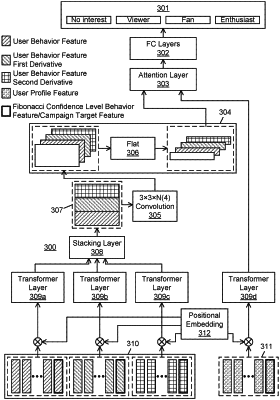| CPC G06Q 30/0264 (2013.01) [H04N 21/4667 (2013.01); H04N 21/4668 (2013.01)] | 27 Claims |

|
1. A method comprising:
providing user program viewership data for each of a plurality of users for a plurality of linear entertainment programs;
creating a behavior shift feature space for acquiring user interest information corresponding to user program viewership behavior over time for the plurality of linear entertainment programs, the behavior shift feature space based on a viewership behavior sequence for each user among the plurality of users, a first derivative on each of the viewership behavior sequences, and a second derivative on each of the viewership behavior sequences;
utilizing a trained machine learning model including a plurality of transformer layers and an attention layer to map user data from the behavior shift feature space into a prediction of a Fibonacci confidence interval level of user interest in a linear entertainment program, season, or episode for each user of the plurality of users, wherein the plurality of transformer layers includes a transformer layer for each of the viewership behavior sequences, the first derivatives on the viewership behavior sequences, and the second derivatives on the viewership behavior sequences, wherein the transformer layers for the viewership behavior sequences, the first derivatives on the viewership behavior sequences, and the second derivatives on the viewership behavior sequences provide outputs to the attention layer through a convolution function, and wherein an additional transformer layer for user profile features for the plurality of users provides additional outputs to the attention layer; and
controlling deployment of an advertising campaign for the linear entertainment program, season, or episode to the plurality of users based on the Fibonacci confidence interval level for each user of the plurality of users.
|